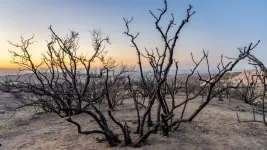(Press-News.org) Southern lesser galagos (Galago moholi), a species of primate that lives in southern Africa, boast big, round eyes and are so small they can fit in your hand.
A new study from an international team of scientists, however, suggests that there may be a downside to their cuteness: The trade in lesser galagos, also known as bushbabies, which some people keep as pets, may have shifted the genetics within their wild populations over the span of decades, according to the research. Those changes could undercut the ability of the critters to adapt as human farms and cities grow throughout the region.
The study was published recently in the journal Primates and was led by researchers from the United States and South Africa, including primatologist Michelle Sauther at the University of Colorado Boulder.
Lesser galagos, she said, are hard to spot: They're nocturnal and live high in the branches of acacia trees. But you may still hear their eerie calls at night in the savannas and forests of South Africa, Botswana, Zimbabwe and other neighboring nations.
"They're called bushbabies because they sound like a baby crying," said Sauther, professor in the Department of Anthropology. "It's kind of spooky."
In their new study, Sauther and her colleagues analyzed the DNA of bushbabies living in the regions around Pretoria and Johannesburg, South Africa, and more remote areas to the north. The team found that populations located far away from each other may share more genes in common than scientists would normally expect--suggesting that something, and probably people, is secretly shuttling the primates around the country.
"You've got populations that are genetically different mixing with each other," said Metlholo Andries Phukuntsi, lead author of the new study and a graduate student at the South African National Biodiversity Institute and the Tshwane University of Technology in Pretoria. "When that happens, you can dilute the local gene pool, and these animals lose their ability to adapt to their habitats."
Bounding bushbabies
Study coauthor Frank Cuozzo said that the findings are significant because scientists today don't know much about these primates, which are cousins to lemurs. But they're worth keeping an eye on, including for their feats of acrobatics.
"From a simple sitting position, they can jump a meter (three feet) into the air, grab a moth and bring it back down," said Cuozzo, a CU Boulder alumnus and primatologist at the Lajuma Research Centre in South Africa.
Those majestic leaps, however, may be growing rarer in parts of South Africa. The country's Limpopo and Gauteng provinces have experienced rapid urbanization in recent decades. In 1980, for example, the Pretoria metropolitan area had an estimated population of about 700,000 people. Today, more than 2.5 million people call the city home.
Sauther suspects that this expansion could be pushing bushbabies out of many areas--and all without anyone knowing.
"What's is worrying is that we talk to farmers, and they're saying, 'We used to see bushbabies back in that orchard, but we don't anymore,'" Sauther said. "That's true even in places like national parks. Some bad things may be happening to them, and it's flying under the radar."
She and her colleagues wanted to find out if southern lesser galagos really are in trouble. To do that, the researchers worked closely with veterinarians to safely collect blood samples from primates living in several different habitats in Limpopo and Gauteng provinces. They then analyzed those samples, plus others kept in biological archives, to take a close look at their mitochondrial DNA--small clusters of genes that mothers pass to their offspring.
Bushbabies on the move
And, as Sauther put it, "something weird is going on."
Phukuntsi explained that, normally, scientists expect that animals that live closer to each other should have more in common genetically than those that live far apart--when wild populations are separated by large distances or barriers like mountains, fewer individuals can travel between them to breed. But what the team discovered in its samples from roughly 40 bushbabies was almost the opposite: Individuals from areas separated by dozens or even more than 200 miles shared a lot of gene mutations. Individuals dwelling within the same populations, in contrast, displayed a surprising amount of genetic divergence.
Something, in other words, seems to be putting the species through the genetic equivalent of a cocktail shaker. And all signs point to the trade in wild animals.
"We think that maybe people are catching them and bringing them to a different area," Phukuntsi said. "But then they become difficult to maintain as pets, so people release them back into the wild."
He added that wild animals have spent thousands of years adapting to the challenges of their particular habitats. If you mix genes up too much, you risk washing away all of those helpful adaptations.
"You can really tell whether a population is healthy or not by looking at its genetic diversity," Phukuntsi said.
For now, the findings suggest that researchers may want to take a closer look at the conservation of these miniature primates. And if you're thinking about keeping a bushbaby in your home: don't, Phukuntsi said. They may be cute, but like all wild primates, they're not well-behaved and don't make good pets.
INFORMATION:
Other coauthors on the study include Morne Du Plessis, Desiré L. Dalton and Antoinette Kotze at the South African National Biodiversity Institute and Raymond Jansen at the Tshwane University of Technology.
Alcohol appears to have an immediate--or near-immediate--effect on heart rhythm, significantly increasing the chance that an episode of atrial fibrillation (AFib) will occur, according to new data presented at the American College of Cardiology's 70th Annual Scientific Session.
The data revealed that just one glass of wine, beer or other alcoholic beverage was associated with twofold greater odds of an episode of AFib occurring within the next four hours. Among people having two or more drinks in one sitting, there was a more than threefold higher chance of experiencing AFib. Using an alcohol sensor placed on participants' ankles, which passively monitored alcohol intake, the investigators ...
As Covid-19 spread around the world, stock markets in individual countries took a major hit - yet stock markets in China where the disease first struck avoided significant falls - researchers at Lero, the Science Foundation Ireland Research Centre for Software found.
A research paper Immune or at-risk? Stock markets and the significance of the COVID-19 pandemic by a Lero team based at University of Limerick confirmed that the growth in COVID-19 cases largely explained changes in stock prices, but surprisingly did not have the same impact in China or on the global index ...
Top experts from Brigham and Women's Hospital presented outcomes from some of the most-anticipated clinical trials in cardiology at the virtual American College of Cardiology's 70th Annual Scientific Session. In four Late-Breaking Clinical Trial presentations, Brigham cardiologists shared their latest findings on strategies to prevent future cardiovascular events in at-risk patient populations, results of a randomized clinical trial of a statin drug among patients critically ill with COVID-19, and more. ...
On Sept. 9, 2018, astronomers spotted a flash from a galaxy 860 million light years away. The source was a supermassive black hole about 50 million times the mass of the sun. Normally quiet, the gravitational giant suddenly awoke to devour a passing star in a rare instance known as a tidal disruption event. As the stellar debris fell toward the black hole, it released an enormous amount of energy in the form of light.
Researchers at MIT, the European Southern Observatory, and elsewhere used multiple telescopes to keep watch on the event, labeled AT2018fyk. To their surprise, they observed that as the ...
The entire ecosystem of the planet, including humans, depends on clean water. When carbonate rock weathers, karst areas are formed, from which around a quarter of the world's population obtains its drinking water. Scientists have been studying how quickly pollutants can reach groundwater supplies in karst areas and how this could affect the quality of drinking water. An international team led by Junior Professor Dr. Andreas Hartmann of the Chair of Hydrological Modeling and Water Resources at the University of Freiburg compared the time it takes water to seep down from the surface to the subsurface with the time it takes for pollutants to decompose ...
Among patients with both heart failure and atrial fibrillation (AFib), treatment strategies focused on controlling the heart rhythm (using catheter ablation) and those focused on controlling the heart rate (using drugs and/or a pacemaker) showed no significant differences in terms of death from any cause or progression of heart failure, according to a study presented at the American College of Cardiology's 70th Annual Scientific Session. The trial was stopped early and, as a result, has limited statistical power to reveal differences between the two treatment approaches; however, trends observed in the study suggest the type of heart failure a patient has may influence which approach is optimal, researchers said.
Heart failure is a condition ...
Irvine, Calif., May 17, 2021 -- Greenhouse gases and aerosol pollution emitted by human activities are responsible for increases in the frequency, intensity and duration of droughts around the world, according to researchers at the University of California, Irvine.
In a study published recently in Nature Communications, scientists in UCI's Department of Civil & Environmental Engineering showed that over the past century, the likelihood of stronger and more long-lasting dry spells grew in the Americas, the Mediterranean, western and southern Africa and eastern Asia.
"There has always been natural variability in drought events around the world, but our research shows the clear human influence on drying, specifically from anthropogenic aerosols, carbon dioxide and other ...
DETROIT (May 17, 2021) - A national study on childhood asthma led by Henry Ford Health System has found that family history, race and sex are associated in different ways with higher rates of asthma in children.
In a study published in JAMA Pediatrics (hyperlink goes here), researchers found that children with at least one parent with a history of asthma had two to three times higher rates of asthma, mostly through age 4. They also reported that asthma rates in black children were much higher than white children during their preschool years, but the rates of incidence dropped in black children after age 9, while they increased for white children later in childhood.
"These findings help us ...
Archaeologists at Northern Arizona University are hoping a new technology they helped pioneer will change the way scientists study the broken pieces left behind by ancient societies.
The team from NAU's Department of Anthropology have succeeded in teaching computers to perform a complex task many scientists who study ancient societies have long dreamt of: rapidly and consistently sorting thousands of pottery designs into multiple stylistic categories. By using a form of machine learning known as Convolutional Neural Networks (CNNs), the archaeologists created a computerized method that roughly emulates the thought processes of the human mind in analyzing visual information. ...
The development of dementia, often from Alzheimer's disease, late in life is associated with abnormal blood levels of dozens of proteins up to five years earlier, according to a new study led by researchers at the Johns Hopkins Bloomberg School of Public Health. Most of these proteins were not known to be linked to dementia before, suggesting new targets for prevention therapies.
The findings are based on new analyses of blood samples of over ten thousand middle-aged and elderly people--samples that were taken and stored during large-scale studies decades ago as part of an ongoing study. The researchers linked abnormal blood levels of 38 proteins to higher risks of developing Alzheimers within ...


